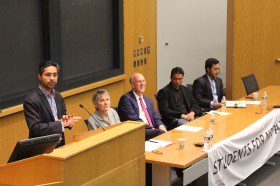
Anuraj Jha, left, Master’s student at Harvard Kennedy School, introduces the second panel on equity in humanitarian response
By Abhishek Raman, MDiv Candidate, Harvard Divinity School; SAI Student Coordinator
As part of the Harvard For Nepal initiative, SAI hosted a panel discussion with Students For Nepal on May 14, 2015, “Consequences and Responses: Lessons from and for Nepal” with faculty from Harvard, Tufts, MIT, and Brown, who shared lessons and recommendations on a wide variety of topics related to Nepal’s recovery.
Xeno Acharya, a PhD student at Harvard T.H. Chan School of Public Health, and member of Students For Nepal, began the event with a moment of silence to honor and remember the families and community members who lost their lives. The first panel focused on “Public Health, Water and Sanitation, and Rebuilding of Places and Heritage Sites,” and was comprised of Jarrod Goentzel, Director, MIT Humanitarian Response Lab; Michael Hooper, Associate Professor of Urban Planning, Harvard’s Graduate School of Design; Daniele Lantagne, Usen Family Career Development Professor, Tufts University; and Atul Pokharel, Postdoctoral Fellow in International Studies, Brown University.
Acharya posed the following three questions to the panelists: (1) How can we ensure proper shelter for the displaced people before the upcoming monsoon season? (2) How can we learn from other humanitarian disaster responses to mitigate destruction and displacement caused by landslides in villages? (3) How can we strike a balance between building new toilets in the immediate future and long-term sanitation infrastructure in Nepal?
Panelists agreed that strong dialogue with the government is necessary to have an engagement with the broader community in Nepal, as all of the formal structures of disaster response are being coordinated by the government. Jarrod Goentzel said, “As 2.8 million people have been displaced in Nepal, the importance of shelter becomes paramount. We need a strong dialogue with the government – and providing shelter should be a strong priority,” he explained. The government is highly restrained in terms of having access to resources to manage the influx of resources that have arrived at the border to support the relief efforts, explained Atul Pokharel.
Daniele Lantagne demystified the popular notion spread by the media that there is always a massive disease outbreak in the aftermath of natural disasters such as the one in Nepal. She explained that flooding is what usually causes outbreaks in the event of natural disasters, and although safe drinking water is necessary, the need of the hour is providing adequate shelter to those displaced.
Michael Hooper discussed parallels between Nepal and the Haiti earthquake in 2010 that killed more than 160,000 and displaced about 1.5 million people. He said that it is important to consider these parallels with Haiti because most organizations that are working to provide relief on the ground in Nepal are the same ones that were working in Haiti.
When the panelists were asked about the role universities such as Harvard can play in providing relief, they replied, “We need to find a way to unleash the creativity of our students and connect them to local partners in Nepal.” However, all panelists stressed the importance of humility while responding to natural disasters such as the one in Nepal. They emphasized the importance of universities building long-term partnerships to effectively contribute to relief efforts.
The second panel focused on “Equity in Humanitarian Efforts,” and was comprised of Jerold S. Kayden, Frank Backus Williams Professor of Urban Planning and Design, Harvard University Graduate School of Design; Ankit Rauniyar, Master’s Candidate, Real Estate Development, Harvard Graduate School of Design; Pukar Malla, Executive Director, Daayitwa and Former Senior Research Fellow, Harvard Kennedy School; and was chaired by Jennifer Leaning, François-Xavier Bagnoud Professor of the Practice of Health and Human Rights; HSPH, Director, FXB Center for Health and Human Rights, Harvard University.
Jerold Kayden stressed that we cannot avoid the questions of “To rebuild or not to rebuild?” given that conventional wisdom tells us to rebuild as quickly as possible. However, it is important to ensure that safety is considered heavily in the rebuilding process. Ankit Rauniyar talked about the challenges of rebuilding Nepal’s infrastructure, and that many of the country’s historical buildings were not designed by architects.
Pukar Malla discussed the importance of taking an inclusive approach to rebuilding: “We shouldn’t exacerbate the already existing culture of dependency,” he said. “We need to make sure these communities are self-sustaining.”
Malla cautioned against rebuilding in these communities so that they are dependent on external forces, as that would not make them sustainable. Rather, he suggested, “we must consider local communities themselves to be resources who come together to help out when there are no external sources available.” Jennifer Leaning remarked that strategic reconstruction should have a bottom-up approach. She said Harvard can play a role in ensuring that there is an equity of voice in the reconstruction process, so that the stories of people on the ground are being told.
Learn more about Harvard For Nepal: https://mittalsouthasiainstitute.harvard.edu/harvard-for-nepal/
Visit our Facebook page to see photos from the candlelight vigil that followed.
